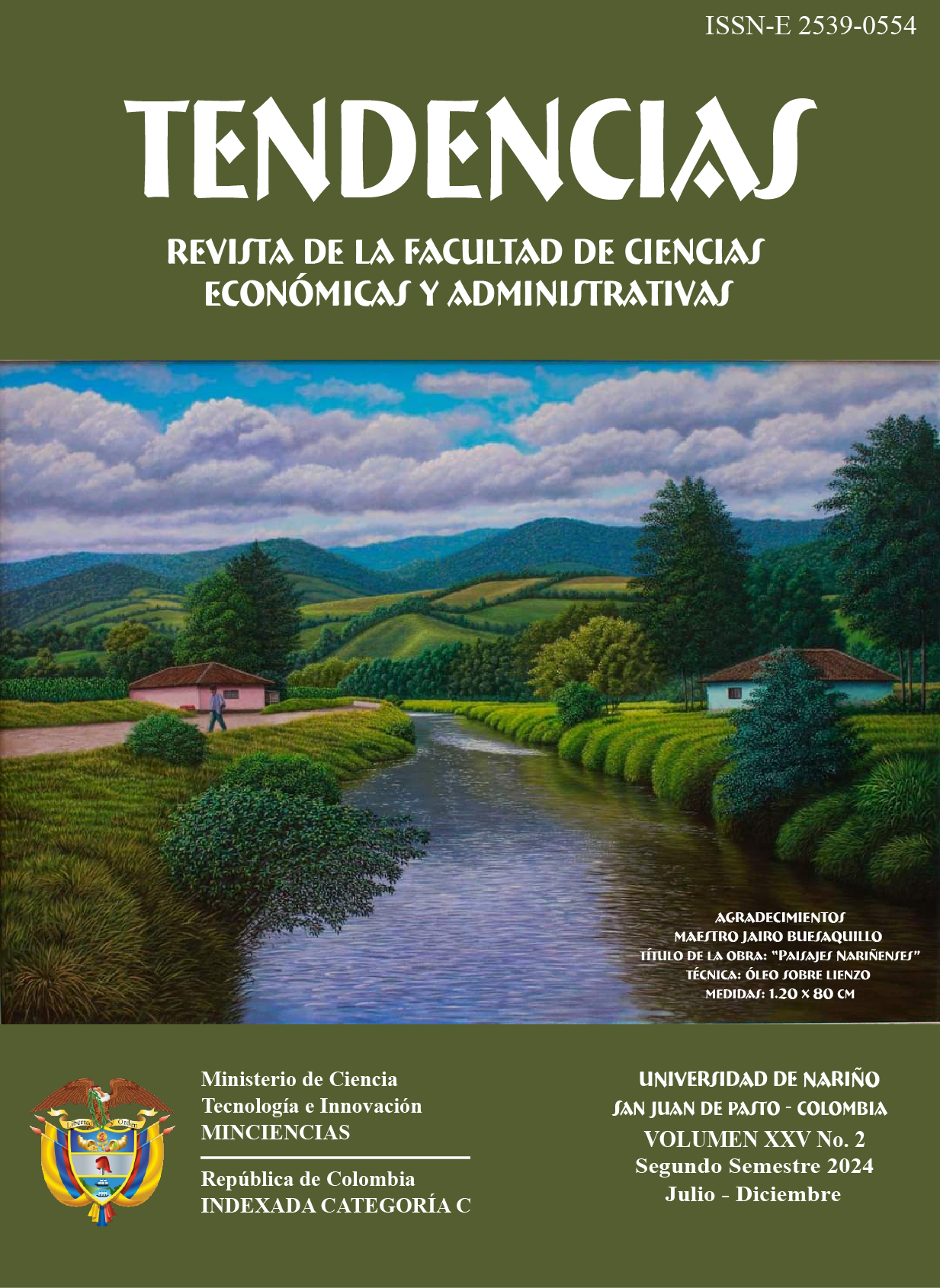Reengineering in emerging businesses: a consequence of the COVID-19
DOI:
https://doi.org/10.22267/rtend.242502.258Keywords:
entrepreneurship, business, growth, reform, technological innovationAbstract
This research explores the repercussions of COVID-19 on global trade and markets during the first half of 2020. The study examines the economic impact of the pandemic on companies, emphasizing the need to rethink the business or redesign it to ensure its response to the challenges that the quarantine represented, as proposed by reengineering in the second half of the 90s of the 20th century. The main objective of this article is to establish a connection between the principles of reengineering and the resilience of startups during the pandemic, reactivating the use of a tool that was used more than 20 years ago. Therefore, the study explores, from a qualitative methodology —with emphasis on documentary research— the relationship between the appearance of the pandemic and the use of some elements of reengineering that can be observed in emerging companies, finding several connections between them. The results highlight how, through reinvention and resurgence, emerging businesses met the challenges of the new normal by maintaining their operations and providing business continuity.
Downloads
References
(1) Becerra, L. (2020) Las Pyme se concentran en el negocio de la fabricación y venta de tapabocas. La República. https://www.larepublica.co/empresas/las-pyme-se-apersonan-del-negocio-de-los-tapabocas-en-el-pais-2986174
(2) Bustos, C. E. (2005). La Reingeniería: Herramienta controversial. Visión Gerencial, 1, 3-(10).
(3) Carvajalino, K. (2020). Reinventando negocios a prueba del Covid-19. Forbes. https://forbes.co/2020/05/08/red-forbes/reinventando-negocios-a-prueba-del-covid-19/
(4) Corte, S. (2020). Emprendedores y empresarios de medianas empresas, en riesgo de quiebra. Caracol Radio. https://caracol.com.co/radio/2020/03/25/politica/1585149564_442396.html
(5) Curran, J., Jarvis, R., Kitching, J. & Lightfoot, G. (1997). The Pricing Decision in Small Firms: Complexities and the Deprioritising of Economic Determinants. International Small Business Journal, 15(2), 17-32. https://doi.org/10.1177/0266242697152001
(6) El Tiempo. (2020). La empresa de bikinis y las 40 más que se reconvirtieron y son éxito. https://www.eltiempo.com/economia/empresas/empresas-que-se-reconvirtieron-en-la-pandemia-487666
(7) Escalera, G. y Escribano, J. I. (2009). La implantación de la Reingeniería en las organizaciones: actividades, técnicas y herramientas. Icade. Revista cuatrimestral de las Facultades de Derecho y Ciencias Económicas y Empresariales, (77), 39-57.
(8) ESIC. (2019). Negocios emergentes, crear algo más que una microempresa. https://www.esic.edu/rethink/tecnologia/negocios-emergentes-rentables
(9) Everett, J. & Watson, J. (1998). Small Business Failure and External Risk Factors. Small Business Economics, (11), 371–390. https://doi.org/10.1023/A:1008065527282
(10) Granada Empresas. (2020). Se publica el Informe de la Situación del emprendimiento en España ante la crisis del COVID-19. https://www.granadaempresas.es/noticias/se-publica-informe-la-situacion-del-emprendimiento-espana-ante-la-crisis-del-covid-19/
(11) Hammer, M. & Champy, J. (1993). Reengineering the Corporation: A Manifesto for Business Revolution. HarperCollins.
(12) Micha, E. (2020). La subcontratación sí está lista. El Economista. https://www.eleconomista.com.mx/opinion/La-subcontratacion-si-esta-lista-20200601-0112.html
(13) Moreno, G. (2020). El uso de las tecnologías VPN se dispara por el coronavirus. Statista. https://es.statista.com/grafico/21151/aumento-de-uso-de-la-vpn-en-paises-afectados-por-el-coronavirus/
(14) O'Ryan, F. (2020). Cuatro casos de empresas que se reinventaron por la crisis sanitaria. La tercera. https://www.latercera.com/pulso/noticia/cuatro-casos-de-empresas-que-se-reinventaron-por-la-crisis-sanitaria/N6B7JQMCFVEEVLNCQ3LGUWGXTU/
(15) Pérez, A. (2018). Negocios emergentes en un mercado: rasgos distintivos. OBS. https://www.obsbusiness.school/blog/negocios-emergentes-en-un-mercado-rasgos-distintivos
(16) Pietrovito, F. & Pozzolo, A. F. (2021). Credit constraints and exports of SMEs in emerging and developing countries. Small Business Economics, 56, 311–332. https://doi.org/10.1007/s11187-019-00225-x
(17) Pineda, D. M. (2016). Startup y Spinoff: definiciones, diferencias y potencialidades en el marco de la economía del comportamiento. Contexto, 5, 141-152. https://doi.org/10.18634/ctxj.5v.0i.657
(18) Probidad en Chile. (2015). Raymond L. Manganelli y Mark M.Klein, Cómo hacer reingeniería. https://www.probidadenchile.cl/wp/manganelli-raymond-y-mark-m-klein-como-hacer-reingenieria/
(19) Revista Semana. (2020a). ¿Quién salvará las pymes? https://www.semana.com/nacion/articulo/quien-salvara-las-pymes-en-medio-de-la-crisis-sanitaria-por-el-coronavirus/662597
(20) Revista Semana. (2020b). 7 emprendimientos de Latinoamérica que se reinventaron en medio de la pandemia. https://www.semana.com/mundo/articulo/7-emprendimientos-de-latinoamerica-que-se-reinventaron-en-medio-de-la-pandemia/670415
(21) Ribó, A. (2020). Reingeniería de procesos: Aprendiendo del reto COVID-19 https://www.esan.edu.pe/conexion-esan/reingenieria-de-procesos-aprendiendo-del-reto-covid-19
(22) Sáez, F., García, O., Palao, J. & Rojo, P. (2006). Reingeniería de procesos (i): características, principios y herramientas de aplicación. En UPM (Ed.), Innovación tecnológica en las empresas (pp. 1-16). Universidad Politécnica de Madrid. http://dit.upm.es/~fsaez/intl/capitulos/5%20-Reingenier%EDa%20_I_.pdf
(23) Singh, P. & Kaur, C. (2019). Factors determining financial constraint of SMEs: a study of unorganized manufacturing enterprises in India. Journal of Small Business & Entrepreneurship, 33(3), 269-287. https://doi.org/10.1080/08276331.2019.1641662
(24) Solís, A. (2020). Emergencia mundial: ¿En qué países se ha ordenado el confinamiento? Economía Digital. https://www.economiadigital.es/politica-y-sociedad/cuarentena-por-coronavirus-en-que-paises-se-ha-declarado-el-confinamiento_20046621_102.html
(25) Sulbarán, P. (2020). Economía y coronavirus: 7 emprendimientos de Latinoamérica que se reinventaron en medio de la pandemia y están prosperando. BBC News Mundo .https://www.bbc.com/mundo/noticias-america-latina-52495847
(26) Vallejo, C. (2020). La crisis del coronavirus destruyó 85.873 empresas en el último mes. El comercio. https://www.elcomercio.es/economia/trabajo/crisis-coronavirus-destruyo-20200414000923-ntvo.html
(27) Ventocilla, E. (1992). Reingeniería de organizaciones. https://cfsbusiness.files.wordpress.com/2011/10/reingenieria-de-organizaciones.pdf
(28) World Health Organization [WHO]. (2020). Preguntas y respuestas sobre la enfermedad por coronavirus (COVID-19). https://www.who.int/es/emergencies/diseases/novel-coronavirus-2019/advice-for-public/q-a-coronaviruses
(29) Wolf, Z. (2020). Las empresas estadounidenses están en crisis. CNN. https://cnnespanol.cnn.com/2020/05/06/las-empresas-estadounidenses-estan-en-crisis/
(30) Wolff-Mann, E. (2020). Coronavirus: Food delivery is 300 times more popular vs. a month ago, according to Yelp data. Yahoo!finance. https://finance.yahoo.com/news/coronavirus-food-delivery-is-300-times-more-popular-vs-a-month-ago-according-to-yelp-data-182100853.html
Downloads
Published
How to Cite
Issue
Section
License

This work is licensed under a Creative Commons Attribution-NonCommercial 4.0 International License.
Those authors who have publications with this journal, accept the following terms:
This journal is licensed under a Creative Commons Reconocimiento-NoComercial 4.0 Internacional License. The articles can be copied, distributed, adapted and communicated publicly, as long as the credits of the work are recognized and the respective source is quoted. This work can not be used for commercial purposes.
To increase their visibility, documents are sent to databases and indexing systems.
The content of the items is the responsibility of each author, and does not compromise in any way, journal or institution.







































